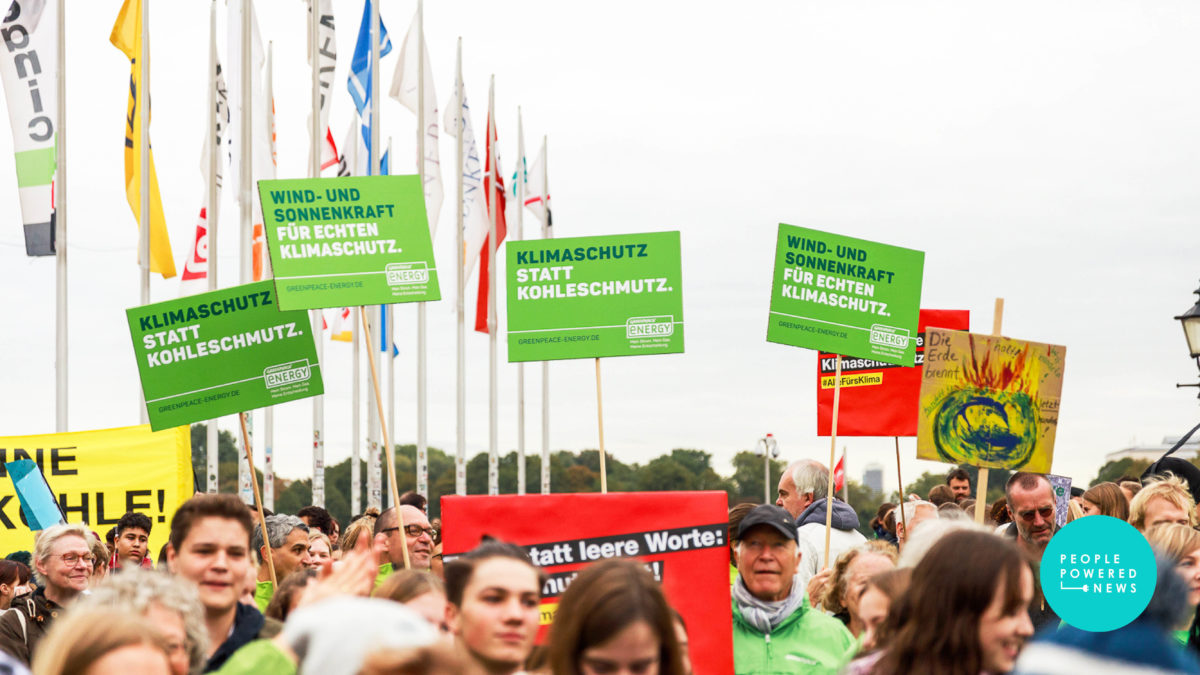Germany’s Greenpeace Energy brands itself as a champion of green energy. But it also sells natural gas.
This is the inaugural feature of our People Powered News initiative launched in partnership with We Don’t Have Time, which contributed to the report.
Greenpeace, the most iconic of environmental organizations, has always been popular in Germany, a nation where many people identify themselves as “green.” Its local office, Greenpeace eV., draws more financial contributions than any other Greenpeace operation in the world. So when Germany deregulated its power markets in the late 1990s, the organization enthusiastically jumped into the business of renewable power with sustainable options like wind and solar. It set up energy cooperative Greenpeace Energy eG in order to change the existing energy markets.
In 2011, already a successful provider of green electrical energy, Greenpeace Energy added natural gas to provide a “back-up” option for the electricity market, the company says. “The energy transition has to take place not only in the electricity sector but in all sectors of our economies. Green gases are crucial for bringing green energy to sectors which cannot be decarbonized with green electricity directly,” says Michael Friedrich, a Greenpeace Energy spokesperson. “That’s why we started proWindgas: to foster the development and production of green hydrogen and to bring about change in the gas sector towards 100% renewable gases.”
“Green gases are crucial for bringing green energy to sectors which cannot be decarbonized with green electricity directly.”
Today, Greenpeace Energy already supplies more than 170,000 households with clean electricity from wind and solar, six times the number of gas customers. Renewable electricity makes up 85% of their turnover. Fifteen percent of its sales are natural gas. It’s also developing green hydrogen with two electrolyzers that produce the hydrogen from excess wind energy.
But it is its natural gas sales that have drawn the most public scrutiny. One Reddit user dubbed it “Gaspeace.” The company also adds a small surcharge to all gas sales to fund the development of hydrogen from renewable energy (“green hydrogen”). It even offers a vegan alternative, proWindgas Vegan, produced from sugar beets.
It even offers a vegan alternative, proWindgas Vegan, produced from sugar beets.
Critics question how the company can use the Greenpeace name and sell natural gas at all because other Greenpeace affiliates around the world oppose the use of natural gas because the effect of methane gas is much stronger than that of carbon dioxide. Greenpeace Energy admits its sale of natural gas “may appear to be a paradox.” “We are aware that the share of fossil fuel in the mix of our products needs to be reduced much faster than in the past,” the company has said. (A more detailed company response can be found in the first posting on WDHT by Goran Falemo.)
How Greenpeace Energy came to this awkward point is linked to a larger energy transformation. In the 1990s, Germany began shifting from coal, oil and nuclear to renewables and natural gas — a journey that has renewables making up 46% of its energy mix. Greenpeace’s answer was to form Germany’s first energy cooperative. Greenpeace Energy is a fully independent company.) (Greenpeace Germany owns a .0015% share of the cooperative and lists Greenpeace Energy on its website.) Of the more than 1,000 energy cooperatives across the country, Greenpeace Energy is the second-largest with more than 27,500 members. “It was really important at the time to bring renewable electricity into Germany’s energy mix,” says an energy executive previously involved with the project, “especially when the country was heavily reliant on nuclear.”
Greenpeace Energy admits its sale of natural gas “may appear to be a paradox.”
Friedrich says Greenpeace Energy is committed to its goal of only selling 100% renewable electricity and says that it has a clear phase-out plan for fossil gas. “We will completely replace fossil gas in our proWindgas products with green gases by 2027 at the latest,” he says. It is also taking steps to increase the amount of biogas it adds to its natural gas. This year, it has begun to offer a new gas mix of 89% natural gas, 10% biogas, and 1% green hydrogen. The company describes this as the most ambitious plan in Germany.
Greenpeace Energy points to a number of factors that it says have so far thwarted its 100% renewable energy goals. These include the high cost to produce green hydrogen, the German government’s long-neglected development of green hydrogen, and because Greenpeace Energy’s customer base who want to heat their homes with proWindgas is growing more rapidly than the amount of green hydrogen available.
By most standards, Greenpeace Energy is a pretty green company.
By most standards, Greenpeace Energy is a pretty green company. It produces 100% renewable electricity from solar and wind. It does not use nuclear or coal. And its gas product is a shrinking element of its overall energy mix that it sells to German households. It is also a vigorous proponent of green hydrogen and continues to accelerate its use of biogas created from organic food waste.
If you buy what Greenpeace Energy is saying, then it’s just a temporary phase on the path to providing 100% renewable energy and gas. Still, the sale of natural gas using the name of perhaps the most well know environmental name in the world, seems to contradict the spirit of Greenpeace.
Editors note. Due to an editing error, a previous version of the story mischaracterized the size of Greenpeace Energy’s gas business. Unlike reported, the energy cooperative does not have 20 million customers but 30,000, natural gas sales are only 15% of total sales and the cooperative’s “near total reliance on gas” is incorrect. These errors have been corrected with modifications suggested by Greenpeace Energy. Climate & Capital regrets the errors made.


